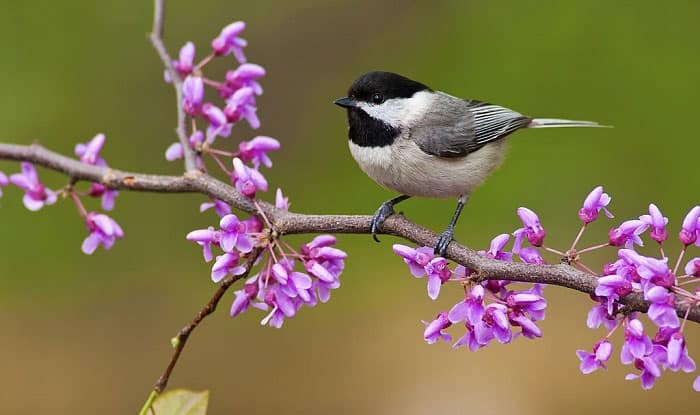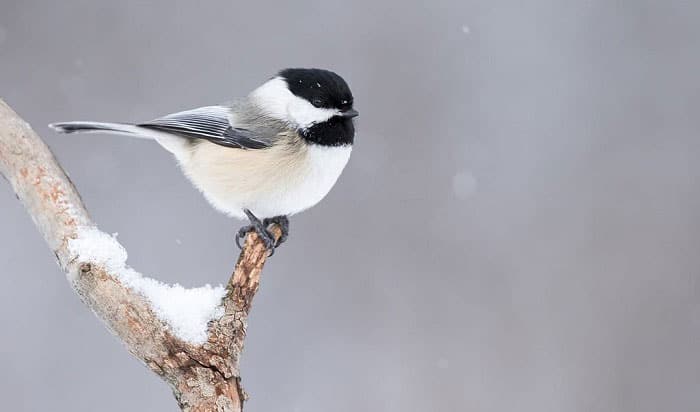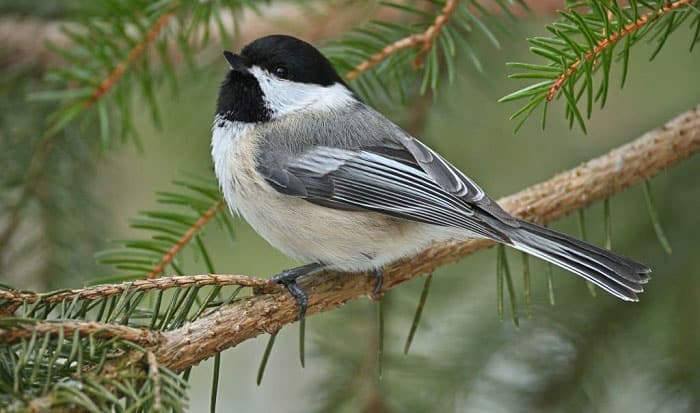What is the state bird of Massachusetts? The black-capped chickadee was made the state bird of Massachusetts through the Legislation of 1941.
This avian species is a tiny passerine songbird with a black bib and cap, a long tail, and short wings and bill. The cheerful nature of this bird makes it exceedingly adorable and fascinating.
All-year round, the non-migratory black-capped chickadees can be found in Northern America. And enthusiastic birders are interested to know what they’re capable of. Through this post, we will explore the fascinating facts of this small songbird.
Table of Contents
Overview of the Black-capped Chickadee
The black-capped chickadee is a common backyard visitor that is omnivorous and fond of stashing food. In fact, this avian species has the ability to hide their food in different places and still locate them after a month.
This bird is monogamous by nature, and male chickadees often sing to attract mates. And once the couples have their young chicks, both parents feed their babies together.
Scientific Classification:
- Kingdom – Animalia
- Family – Paridae
- Species – P. atricapillus
- Genus – Poecile
- Phylum – Chordata
- Class – Aves
- Order – Passeriformes
- Binomial name – Poecile atricapillus
The Massachusetts state bird is an enthusiastic avian that is friendly to humans. And aside from Massachusetts, the black-capped chickadee is also the state bird of Maine.
The positive manner in which this bird looks at life complements the happy perspective of the residents of the state they represent.
Chickadees are also super cute with their tiny bodies that look like they’re sporting a tuxedo. Their beaks have a silver hue and a short length of 8 to 9.5 mm.
Physical characteristics:
- Length – 4.7-5.9 inches
- Wingspan – 6.3-8.3 inches
- Weight – 9-14 grams
- Beak – 8-9.5 millimeter
- Wings – 2.50-2.66 inches
- Tarsus – 0.63-0.67 inches
- Tail – 2.3-2.5 inches
As non-migratory birds, the black-capped chickadees thrive in the evanescent woodlands, willow thickets, open woods, cottonwood orchards, nature parks, and forests.
During nesting time, this avian species prefers small tree cavities, nest boxes, and cavities left by the Downy woodpeckers.
The females select the nesting spots and build the typical cup-shaped nests inside a 21cm deep chamber. The nests are typically above ground, and it’s possible to attract chickadees if you give them a nest box.
Fascinating Facts About the Black-capped Chickadee
The chickadee is also known as the dickybird, the tomtit, and the titmouse. This avian species is super friendly to their flock, as well as with other birds. Their cheerful singing resembles a beautiful call of “Chick-adee-dee-dee”.
There are other fascinating facts about this tiny songbird that every bird enthusiast should know about.
Fact #1: Behavior
The black-capped chickadees are highly sociable creatures that live an active lifestyle, usually with their flocks. They are fond of hanging out with warblers, woodpeckers, vireos, nuthatches, and even with humans.
These birds like people, and they are often seen perching on human hands to feed. With their lively songs and cheery disposition, residents and tourists are fond of these adorable birds.
Fact #2: Life Cycle
The male birds forage for food to give to their mates and their young after hatching. Young chicks leave the nests after 12 to 16 days, and they become independent relatively quickly (at 5 to 6 weeks of age).
During their lifespan, these birds are part of a nuclear family. They typically live for 6 years on average.
Fact #3: Diet
The official state bird Massachusetts loves to eat meat, fruits, insects, and seeds. In truth, they seem to enjoy insects the most.
Chickadees like finding new food sources and are so good at it that other birds may follow them.
If you have feeders with sunflower seeds, these birds may take them to tree branches.
Fact #4: Winter Survival
The black-capped chickadees are smart creatures that have the right instincts to weather the freezing days and nights.
This bird species has the capability to reduce the temperature of their body by 12 to 15℉ to achieve a controlled hypothermia state. This process, along with the creation of more feathers, help chickadees conserve energy and stay warm.
Fact #5: Vocalization
There are thirteen vocalizations that are recognized from the black-capped chickadees, and they are mostly complex. Through analysis of chickadees’ fee-bee songs, it is possible to identify whether the singing bird is male or female.
Fact #6: Disposing Brain Neurons
During the fall season, the black-capped chickadees dispose of their old neurons to rid their brains of useless data. The hippocampus region of the bird’s brain swells every October, which leads to the dying of the older brain cells.
And then new ones come alive to help the birds adapt to the changes of seasons and survive.
Fact #7: Conservation
The population of the Massachusetts bird is around 41 million, and they can fly at 20 km/h.
The black-capped chickadees are not at risk of going extinct, but of course they still need to be cared for and loved. These bird species are found in North America and Canada, and their numbers are increasing.
Fact #8: Flock
The black-capped chickadees are very friendly, and they are usually with a flock. The group of birds are recognized as the “banditry”, as well as a “dissimulation”.
However, while roosting, the avians prefer to be alone or with their mate in tree cavities or in groves, or wherever they opt to rest. And in terms of singing, the birds only sing when they are apart from the flock.
Fact #9: Beneficial For Humans
Insects have always been a problem for humans who have gardens on their properties. The black-capped chickadees love to munch on caterpillars and bugs that are harmful to the plants and flowers we grow.
In this sense, this avian species is truly beneficial to humans. So feeding them is indeed a good thing and helpful too.
Fact #10: Nest Materials
The black-capped chickadees are more than capable of making their own nests. But humans can also help them build their nests by purposely leaving wood shavings and sawdust in places where birds can find. This is especially beneficial during the winter.
If you plan to help the birds create new nests, then your goal may be realized soon. These avians are trusting creatures, so they’ll surely accept the ready materials for their homes.
Conclusion
Now that you know what is the state bird of Massachusetts, you can easily enjoy the company of these sociable birds. As for your feeder, thankfully, the black-capped chickadees are not picky eaters.
Fill your bird feeder with suet, cornmeal, peanut butter, pumpkin seeds, ragweed, conifers seeds, wild fruit, goldenrod, and sunflower seeds. The good news is you can stay close while they feed, since they’re not scared of humans.
We hope you liked this post. Kindly share this to your social media so others may see it too. And feel free to let us know what you think.
Moreover, discover our article about other state birds like:
- Some interesting facts about the Eastern bluebird of New York.
- State bird of Kansas and their facts.
- What is the state bird of Alabama?

George and I became friends after a birdwatching trip with our new group. And we have been enjoying every adventure together. When he told me the idea of establishing a site that shares our experiences and fun, I immediately agreed. After trials and errors, here we have Thayerbirding.

















